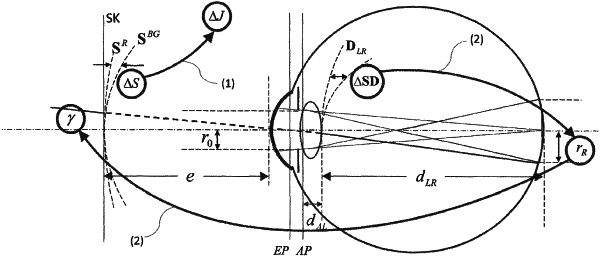| CPC G02C 7/028 (2013.01) [G02C 7/027 (2013.01); G02C 2202/22 (2013.01)] | 16 Claims |

|
1. A computer-implemented method for calculating or assessing a spectacles lens for an eye of a spectacles wearer, comprising:
(a) providing a comparative association of at least one imaging property or aberration of a spectacle lens system with a visual acuity of the spectacles wearer when observing an object through the spectacle lens system, wherein the spectacle lens system is a combination of the spectacles lens and the eye or an eye model of the spectacles wearer, and the spectacles wearer is a specific spectacles wearer or an average spectacles wearer;
(b) determining or prescribing a target function for the spectacles lens to be calculated or assessed, in which the association from step (a) is to be evaluated; and
(c) calculating or assessing the spectacles lens to be calculated or assessed by evaluating the target function,
wherein:
Vreal(ΔUs,j(i)) designates the vision acuity, which is determined using the association and an actual value of the at least one imaging property of the spectacle lens to be calculated or assessed at the i-th assessment point,
the subscript s designates an arbitrary evaluation surface of the at least one imaging property or aberration, and
the subscript j,j≥1 designates a j-th imaging property or aberration, and
wherein the target function that depends on the visual acuity V via the association of the at least one imaging property or aberration ΔUs,j with the visual acuity of the specific spectacles wearer or of the average spectacles wearer is represented as:
 wherein:
Gs,j,iV designates weighting of the visual acuity at the i-th assessment point, prescribed by the association with the at least one imaging property or aberration ΔUs,j(i), and
Vtarget(ΔUs,j(i)) designates a target value of the visual acuity.
|